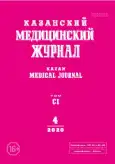Практика применения и пути совершенствования критериев установления степени утраты профессиональной трудоспособности на территории Российской Федерации
- Авторы: Севастьянов М.А.1, Пенина Г.О.1, Деденева И.В.1, Чистякова Н.П.1, Божков И.А.2
-
Учреждения:
- Санкт-Петербургский институт усовершенствования врачей-экспертов
- Северо-Западный Государственный медицинский университет им. И.И. Мечникова
- Выпуск: Том 101, № 4 (2020)
- Страницы: 544-549
- Тип: Социальная гигиена и организация здравоохранения
- URL: https://ogarev-online.ru/kazanmedj/article/view/25733
- DOI: https://doi.org/10.17816/KMJ2020-544
- ID: 25733
Цитировать
Аннотация
Цель. Оценить практику применения действующих в настоящее время «Временных критериев по определению степени утраты профессиональной трудоспособности» в различных субъектах Российской Федерации и обосновать основные направления их совершенствования.
Методы. Проведён анализ экспертных решений по установлению степени утраты профессиональной трудоспособности, принятых в период с 2015 по 2017 гг. в 77 субъектах Российской Федерации по двум нозологическим формам: (1) последствия травм нижней конечности (Т93) и (2) двусторонняя нейросенсорная тугоухость (H83.3). Проведён сравнительный анализ экспертных решений, принятых с использованием действующих и предложенных авторами критериев, в двух субъектах Российской Федерации в 2018 г. В ходе анализа использовали методы описательной статистики.
Результаты. С учётом высокого уровня вариативности принятия экспертных решений в субъектах РФ по аналогичным экспертным случаям (коэффициент вариации 21,6%) авторами сделан вывод о необходимости изменения подходов к методологии оценки характера профессиональной деятельности (квалификации, качества и объёма труда, способности к его выполнению). Использование предложенных авторами критериев, базирующихся на концепции разумного приспособления, позволило достоверно снизить вариативность принятых решений в «пилотных» регионах, коэффициент вариации снизился с 21,25 до 7,43%.
Вывод. Высокая вариативность принимаемых решений в ходе экспертизы степени утраты профессиональной трудоспособности связана с несовершенством методики и критериев оценки профессиональной деятельности пострадавших; использование предлагаемых авторами критериев позволяет обеспечить более высокую воспроизводимость результатов проводимых экспертиз.
Полный текст
Открыть статью на сайте журналаОб авторах
Михаил Александрович Севастьянов
Санкт-Петербургский институт усовершенствованияврачей-экспертов
Автор, ответственный за переписку.
Email: mike.seva1972@yandex.ru
Россия, г. Санкт-Петербург, Россия
Галина Олеговна Пенина
Санкт-Петербургский институт усовершенствованияврачей-экспертов
Email: mike.seva1972@yandex.ru
Россия, г. Санкт-Петербург, Россия
Ирина Владимировна Деденева
Санкт-Петербургский институт усовершенствованияврачей-экспертов
Email: mike.seva1972@yandex.ru
Россия, г. Санкт-Петербург, Россия
Наталья Петровна Чистякова
Санкт-Петербургский институт усовершенствованияврачей-экспертов
Email: mike.seva1972@yandex.ru
Россия, г. Санкт-Петербург, Россия
Игорь Александрович Божков
Северо-Западный Государственный медицинский университетим. И.И. Мечникова
Email: mike.seva1972@yandex.ru
Россия, г. Санкт-Петербург, Россия
Список литературы
- Гаркуша Л.Г., Баранова Л.Ю., Забирова В.И. Судебная практика ФГУ Главное бюро медико-социальной экспертизы по Иркутской области по обжалуемым решениям об установлении степени утраты профессиональной трудоспособности застрахованным от несчастных случаев на производстве и профессиональных заболеваний. Мед.-социал. экспертиза и реабилитация. 2012; (3): 40–42.
- Панина И.А., Левиков Г.В. Актуальные вопросы медико-социальной экспертизы и реабилитации больных профессиональными заболеваниями. Мед.-социал. экспертиза и реабилитация. 2001; (3): 19–24.
- Данилова С.Г., Панов А.В. При проведении медико-социальной экспертизы пострадавших от несчастных случаев на производстве и профессиональных заболеваний нормы закона являются определяющими. Мед. экспертиза и право. 2011; (1): 8–14.
- Сытин Л.В., Жестикова М.Г. Проблемы инвалидности и реабилитации инвалидов от трудового увечья в Кузбассе. Политравма. 2014; (3): 83–88.
- Заключительные замечания по первоначальному докладу Российской Федерации. Приняты на 19-й сессии Комитета по правам инвалидов ООН 14 февраля — 9 марта 2018 г. https://rosmintrud.ru/docs/mintrud/handicapped/272 (дата обращения: 20.01.2020).
- Зайцев В.М., Лифляндский В.Г. Прикладная медицинская статистика. СПб.: Дизайн. 2000; 299 с.
- Федина И.Н., Преображенская Е.А. Особенности снижения слуха, вызванного воздействием шума в современных условиях. Мед. труда и промышл. экология. 2017; (9): 200.
- Артамонова В.Г., Мухин Н.А. Профессиональные болезни. М.: Медицина. 2004; 479 c.
- Севастьянов М.А., Коробов М.В., Владимирова О.Н., Божков И.А. Роль учреждений медико-социальной экспертизы в организации страхового обеспечения и реабилитации пострадавших на производстве. Вестн. Всероссийского общества специалистов по мед.-социал. экспертизе, реабилитации и реабилитационной индустрии. 2017; (1): 11–19.
Дополнительные файлы






